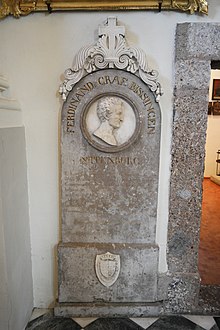Ferdinand von Bissingen-Nippenburg
Ferdinand Ernst Maria Anton Graf von Bissingen-Nippenburg (* February 2, 1749 in Wilten ; † April 22, 1831 ibid) was an Austrian civil servant and politician.
Life
His parents were Joseph Kajetan Leopold Graf von Bissingen and Nippenburg , at that time treasurer and councilor in the Upper and Upper Austrian government in Innsbruck , and his wife, Freiin Amalia Antonia von Spaur-Flavon . The paternal family came from Upper Austria ( Schramberg ). Ferdinand von Bissingen-Nippenburg sold the Grundsheim estate to the princes of Thurn and Taxis in 1789 .
In 1774, Count Ferdinand married Maria Anna Amalia von Stotzingen , after whose death he married Maria Countess von Thurn-Valsassina in 1798 .
career
Ferdinand Ernst Maria studied in Konstanz , Freiburg im Breisgau and Würzburg with excellent results.
He obtained the preparation for higher civil service at the Imperial Court Chamber Court in Wetzlar .
As a result he became
- Electoral Cologne Chamberlain
- 1787–1791 Landvogt in Oberberg and Hohenberg in Rottenburg am Neckar
- 1791 kk chamberlain and councilor
- 1792 Ober-Landeskommissär in the Imperial and Royal Rhine Army
- 1794 President of the Upper Austrian Land Rights
- 1797–1801 governor of Tyrol - Vorarlberg
- 1802 to 1805 Court Commissioner and Governor General of the Venetian provinces that have just become Austrian
- At the beginning of 1806 extraordinary commissioner for the administration of the Duchy of Salzburg, which had just become Austrian
- 1807–1809 (according to others: 1805–1809) President (of the provincial government) of the Archduchy of Austria under the Enns , 1810 honorary citizen of Vienna
- 1809 takeover court commissioner in the provinces of Styria and Carinthia (which fell to France in the Peace of Schönbrunn in 1809 )
- 1810 to 1815 governor of Styria
- 1815 to 1819 again governor of Tyrol and Vorarlberg, in 1816 also provincial governor (and entrusted with the re-acceptance of Tyrol into the Austrian administration).
- In 1819/1820, as governor of Veneto , he dedicated himself to the stabilization of Austrian rule in this area, which had become Habsburg again in 1815; according to another source (Waller Chronicle), he retired in 1819.
With a resolution of September 26, 1819, in recognition of his work, he received a royal Hungarian cameraman rule (donatio regia mixta).
Others
He had a son, Cajetan von Bissingen-Nippenburg , who also became governor of Veneto and Tyrol . Both tombs are located in the Wilten basilica .
swell
- “Wiltener personalities” at www.wiltener-schuetzen.dic.at
- "The Lower Austrian Provincial Government 1501 to today" on the Marienthal website of the archive for the history of sociology in Austria ( Memento from April 6, 2008 in the Internet Archive )
- List of provincial governors of Carinthia (including the governors and governors in Graz)
- www.herrschaft-schramberg.de
literature
- Richard Schober: History of the Tyrolean Parliament in the 19th and 20th centuries. Universitätsverlag Wagner, Innsbruck 1984. ISBN 3-7030-0131-3 .
- Bissingen-Nippenburg Ferdinand Ernst Maria Graf von. In: Austrian Biographical Lexicon 1815–1950 (ÖBL). Volume 1, Verlag der Österreichischen Akademie der Wissenschaften, Vienna 1957, p. 88.
- Karl Otmar Freiherr von Aretin: Bissingen and Nippenburg, Ferdinand Graf von. In: New German Biography (NDB). Volume 2, Duncker & Humblot, Berlin 1955, ISBN 3-428-00183-4 , p. 279 ( digitized version ).
Individual evidence
- ^ Richard Schober, 1984: Count Ferdinand von Bissingen-Nippenburg, pp. 517-518.
| personal data | |
|---|---|
| SURNAME | Bissingen-Nippenburg, Ferdinand von |
| ALTERNATIVE NAMES | Bissingen-Nippenburg, Ferdinand Ernst Maria Anton Count of |
| BRIEF DESCRIPTION | Austrian provincial governor |
| DATE OF BIRTH | February 2, 1749 |
| PLACE OF BIRTH | Wilten |
| DATE OF DEATH | April 22, 1831 |
| Place of death | Wilten |


